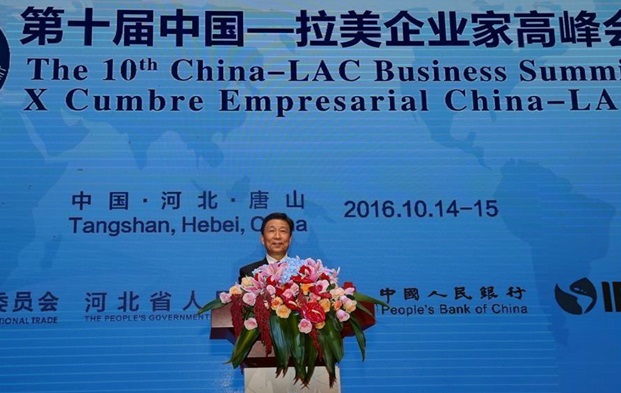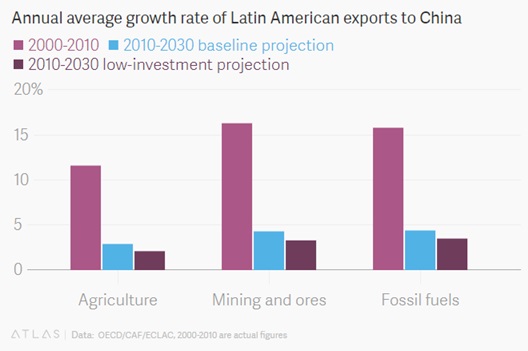A Key Partner for the Development of Latin America?
By Harold Murphy
 随着“一带一路”政策的推广发展,中国企业面向海外的发展脚步越来越快,我国政府及企业不仅与非洲、东南亚各国有广泛的交流合作,与拉美地区各国的发展也从未间断。在2016年,第十届中国—拉美企业家高峰会就在河北唐山举行;同期,中国—拉美产业合作与商品展举行;去年,江淮汽车与墨西哥吉安特汽车公司达成合作协议,联合向墨西哥伊达尔戈州一座工厂注资44亿墨西哥比索。江淮汽车通过在墨西哥的经营,希望逐渐完成产品和品牌的升级。此类中国与拉美之间的交流合作在近年也越来越多,且从能源领域拓展逐渐覆盖了制造业、电力、农业等多个产业,如食品加工、电子产品、IT、纺织、风能设施建设、旅游、金融服务、法律服务、花卉、渔业等。中拉之间的合作正在朝着更广阔的领域发展。
随着“一带一路”政策的推广发展,中国企业面向海外的发展脚步越来越快,我国政府及企业不仅与非洲、东南亚各国有广泛的交流合作,与拉美地区各国的发展也从未间断。在2016年,第十届中国—拉美企业家高峰会就在河北唐山举行;同期,中国—拉美产业合作与商品展举行;去年,江淮汽车与墨西哥吉安特汽车公司达成合作协议,联合向墨西哥伊达尔戈州一座工厂注资44亿墨西哥比索。江淮汽车通过在墨西哥的经营,希望逐渐完成产品和品牌的升级。此类中国与拉美之间的交流合作在近年也越来越多,且从能源领域拓展逐渐覆盖了制造业、电力、农业等多个产业,如食品加工、电子产品、IT、纺织、风能设施建设、旅游、金融服务、法律服务、花卉、渔业等。中拉之间的合作正在朝着更广阔的领域发展。
除工业制造业,金融对于增强中拉伙伴关系也非常重要。 中国已经宣布拉丁美洲为其金融投资的优先区域。自2010年以来,仅中国的贷款就达到940亿美元,中国在拉丁美洲的直接投资,尤其在通信、电力、绿色科技和购置土地等方面的投资形成了我国在该地区今时今日的地位。
由拉美各国组成的政策银行CAF首席执行官 Enrique Garcia坦言,虽然中国与拉美在许多领域有合作的机会,如物流,基础设施领域,金属矿产等,但是拉美也有许多功课要做,解决其内部的问题也需要一个长期过程,“包括提高教育水平,投资环境改善及相关政策完善等等”。因此,构建面向发展的中拉合作伙伴关系是互利共赢的,但需要全球治理。中国的转型可能会加快拉丁美洲经济复苏的进程,但是拉美地区需要更好的法治、保证环境的可持续性、更为透明的执行力来对接中国的转型。总之,中国需要从整体上理解拉丁美洲的发展挑战,构建一个以未来可持续发展为目标的合作对话机制。
 In the recent years, China has emerged as a key player in the process of economical and structural development and regional integration of Latin America. This became especially apparent as the US President, Donald Trump, promised to renegotiate the US trade deals with the region as part of his “America First” strategy, which invited China to Latin America with its own agreements. And since then, both trade and economic cooperation between the two regions has blossomed.
In the recent years, China has emerged as a key player in the process of economical and structural development and regional integration of Latin America. This became especially apparent as the US President, Donald Trump, promised to renegotiate the US trade deals with the region as part of his “America First” strategy, which invited China to Latin America with its own agreements. And since then, both trade and economic cooperation between the two regions has blossomed.
Political Presence of China in Latin America
The China-Latin America partnership has benefited from Trump’s suggestion that the United States may pull out of NAFTA and from the US focus in the Middle East in recent years. China has long been seen as a potential partner and alternative to the United States by countries of Latin America which believed that involvement of China in the region would be beneficial for infrastructural projects and positive economic growth.
China didn’t wait long after Mr. Trump announced his plans to pull the USA out of NAFTA, and entered Mexico’s automobile industry promptly with the Chinese JAC Motors investing $200 million in the Giant Motors factory.
Beijing has signed a number of bilateral agreements with Latin American countries, such as Costa Rica, which now has a Free Trade Agreement with China. Creation of the BRICS group (Brazil, Russia, India, China and South Africa) also had a major impact on the deepening of relations between China and Brazil. The 6th BRICS summit, held in 2014 in Fortaleza, Brazil, resulted in the official inauguration of the New Development Bank – an alternative to the World Bank and International Monetary Fund.
The China-Latin America partnership and the Caribbean Business Summit, founded in November 2007, are among the first platforms to promote economic cooperation between the regions. This Summit is held once a year on a rotation basis between countries of Latin America and China, with the eleventh Summit scheduled between 30th November and 2nd December 2017 in Punta del Este, Uruguay.

Chinese Vice President, Li Yuanchao, attending the 10th China-LAC Business Summit.
Source: China Daily
The China-LAC Business Summit is incorporated into the Cooperation Plan between China and Latin American and Caribbean Countries (2015-2019), which was signed in Beijing in January 2015 and covers the guidelines for mutual investment in various industries, including mechanical equipment, petrochemicals, medical equipment, information and communication technology and other.
Trade and Economic Relations between China and Latin America
Significant trends are witnessed not only in political partnerships but also in areas of trade and finance, where China has become the main source of international capital in Latin America and the largest trade partner for Brazil, Chile and Peru. Only the United States remains the main trading partner when considering all countries of Latin America. According to OECD’s Latin American Economic Outlook 2016, the partnership between China and Latin America has multiplied 22-fold since 2000 and the value of trade had totaled to more than $240 billion in 2011.
 The World Bank states in its report that Latin American countries are so dependent on the performance of Chinese economy that a fall of one percentage point in Chinese growth would decrease the growth in Latin America by 0.6%.
The World Bank states in its report that Latin American countries are so dependent on the performance of Chinese economy that a fall of one percentage point in Chinese growth would decrease the growth in Latin America by 0.6%.
Majority of Latin American exports to China are unprocessed energy resources, minerals and food - which account for over 70% of the exports to China. On the other hand, as China exports manufactured goods of varying sophistication to the region, this trade pattern could have a direct negative impact on the development of various industries in Latin America.
In fact, export of raw materials to China may slow down in the coming decade, as the Chinese economy peaked in mid 2015 and is now growing more modestly which pushes the demand and price for raw materials down. The following chart shows the expected annual growth rate of Latin American exports to China. Countries that depend most on mining and raw materials, like Chile and Peru, could be hit hard.
 On the other side, China’s presence in Latin America is concentrated in just a few countries, with Brazil, Chile and Mexico comprising 60% of the total trade volume between the region and China. Furthermore, Chinese loans to Latin American countries are even more concentrated, with Brazil, Argentine, Venezuela, Bolivia and Ecuador receiving more than 90% of the total $120 billion Chinese loans to the region, out of which $30 billion was lent in 2015 alone.
On the other side, China’s presence in Latin America is concentrated in just a few countries, with Brazil, Chile and Mexico comprising 60% of the total trade volume between the region and China. Furthermore, Chinese loans to Latin American countries are even more concentrated, with Brazil, Argentine, Venezuela, Bolivia and Ecuador receiving more than 90% of the total $120 billion Chinese loans to the region, out of which $30 billion was lent in 2015 alone.
Summary
According to Enrique Garcia, President of CAF, “Latin America and China must work together in the deepening of a dynamic, long-term and strategic relationship based on a common agenda. Such a relationship should promote symmetry in trading relations, technology transfers and strategic investments”. Indeed, China has a growing influence in Latin America that no longer can be neglected by the United States and Europe. The multifold increase in trade volume and economic cooperation was beneficial for both regions, but a slowdown in China’s economic growth and demand for commodities – the main export of Latin America to China – could mean hard times for some of the countries in Latin America which are heavily dependent on China’s economy.
---END---